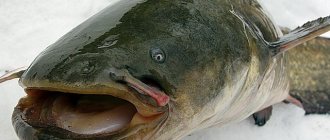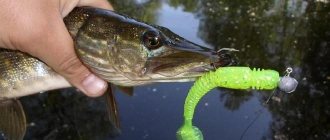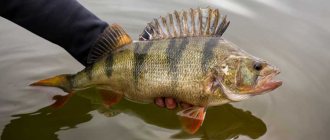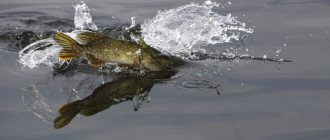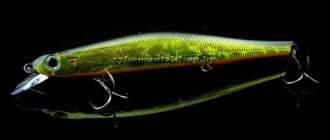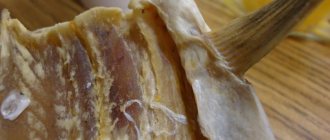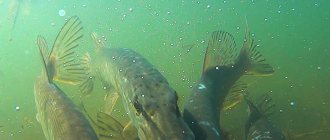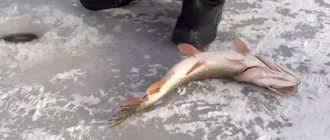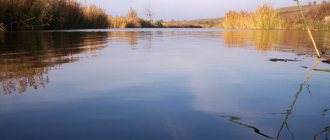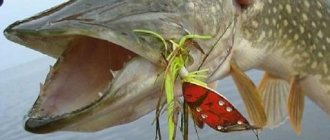Where to find pike in autumn
Photo: Pike in autumn
With the onset of autumn cold weather, the predator quickly changes locations in the reservoir, looking for the most profitable food supply and shelter for hunting. The best option for fishing at this time is to use a watercraft. Onboard fishing allows you to cast into snags and hard-to-reach places with minimal risk of leaving caught gear. The boat also allows for quick redeployment after unsuccessful catches.
Lake, pond
In bodies of water with relatively stagnant water (lakes), the spotted predator easily finds ambush sites. It can be:
- drowned snags or flooded trees;
- thickets of reeds;
- the edge of a carpet of aquatic vegetation;
- thickets of water lilies;
- bays or exits from deep holes.
A pond is a hydrological system in which there is a certain flow. The oxygen regime of the reservoir does not allow any other predatory fish to live there except pike (in some cases perch). The behavior of fish in this ecosystem is specific. Pike hide along the flooded riverbed, at the bends of the watercourse, where there are grass “caps”.
On the river, on small rivers
The large river is home to large trophies, while the small river is home to medium-sized pike or grass pike. The differences between such reservoirs are the current and the constantly changing bottom topography. You can find a toothy one by adhering to the following rules.
- Fish do not like fast currents. She is hiding in the creek.
- The predator hunts only along the riverbed and shoreline.
- The main places of shelter are snags, reeds, and rare algae.
- The likelihood of meeting a pike increases near schools of small fish.
The fish prefers places with variable depth: the more irregularities in the river, the better. Catching pike in rivers is more difficult than in standing reservoirs, but it is more interesting and exciting.
Pike habitats
In the vicinity of the fishing and hunting recreation center Markovo there are several rivers and lakes. In all of the listed reservoirs you can successfully catch pike.
Lake pike is divided into two categories: large (4-5 kg or more) and “standard” up to 4 kg. Large - prefers the deepest places of the reservoir in cluttered places. These could be: flooded snags, places with an accumulation of large stones. Pike can also hide near single shelters, from which it attacks large fish. The rest prefer shallower places. Such masses include: shallow bays with abundant vegetation, coastal reeds, sedges, pebble and stone shallows. Likes to hide near individual grass islands, sometimes “patrolling” the edges.
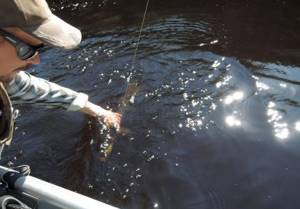
The behavior of river pike is somewhat different; the size of the reservoir makes itself felt. The river does not have the same expanse as the lake; it peacefully coexists with other inhabitants of the reservoir, and quite often occupies places before and after the riffle, where juvenile fish come out to feed. Pike fishing on the river is carried out: directly on riffles, places with low currents, small pressures, and whirlpools. Sometimes pike can come out to feed directly on the stream.
In places with weak river flows, pike occupy coastal places near the shore in the rubble of logs that clog the river. In places with reaches, it occupies the entire width of the river, hiding near any shelter.
Don’t forget that a lot can change depending on a lot of factors: water level, time of year, atmospheric pressure, etc.
How and what to catch pike in autumn
Autumn pike fishing allows for the use of a variety of baits. The main thing is to choose the gear that is most suitable for the existing conditions.
Tackle
There are several types of gear with which you can hunt for pike:
- Spinning fishing with artificial bait. Spinning remains the best tool for autumn pike fishing. The characteristics of the gear are selected based on the month of fishing. In September, they take a short spinning rod: no more than 240 cm. During this period, the pike continues to feed in the coastal zone; there is no need for long casts yet. Other indicators of the tackle are a middle class blank, medium-fast action (test from 5 to 20 g). With the arrival of cold weather, the length of a suitable spinning rod increases: the optimal size is 270 cm. The build is fast.
- Mugs . You also need to pay attention to the mugs. These are large-sized reels on which 10-20 m of fishing line is wound (section 0.30-0.35 mm). The exact weight depends on the size and mobility of the chosen bait. Autumn pike can be caught both on drifting circles and on stationary ones tied to reeds, snags, a tree on the shore, etc.
- Fishing with a float using live bait. The float is selected that will be 2 times the weight of the bait. The element can be fastened in a stationary or sliding position. The second option is preferable for deep reservoirs. It is recommended to take floats that have a bright-colored signal ball. At the same time, the device itself should be inconspicuous, matching the color of the water.
About
Tackle for catching pike in the river
When we go river fishing, we need to focus on the maximum size of the fish we want to catch. The river pike we catch is usually from 1 to 3 kg. Occasionally, crocodiles are caught, but this does not happen often. We will start from this, since unlike lake fishing we will still have to walk. Pike fishing on small rivers has its own characteristics. With a maximum river width of 20 meters, an 8 foot rod will already be too long. I would recommend choosing a 7ft rod with 7-20g cast. The action of this rod is Fast. We'll take a smaller coil. I recommend limiting yourself to models 2500, 2508. We equip them with braided fishing line according to the recommendations on the spool.
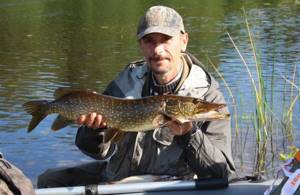
Uncoupling
Before we move on to analyzing baits, I want to mention such an irreplaceable thing as a release. When fishing in a small river, it is not necessary, but when fishing on a lake and deep river places it will come in handy. It’s hard for me to say why, but many people forget about such an important fishing accessory. Fishing with expensive wobblers and spinners without unhooking is too wasteful.
There are two types of uncouplings: “breaker” and “hooking”. The first ones hit the bait with their weight and at the moment of impact they detach from the obstacle. They are ineffective when fishing with wobblers; they are suitable for winter fishing, when we fish with balancers and spoons. “Hooking” ones operate on a different principle; they have a dozen metal loops in their design, the task of which is to “catch” a free hook. Almost all wobblers have a pair of tees, which means that you have a much greater chance of hooking it. In the process of releasing the bait using this method, sometimes the tees become unbent, but you must agree that replacing the tee is not replacing the bait. When going fishing, take a cutter. This will save a lot of time and nerves.
Don't believe me? Find a video online. It couldn't be easier to use!
When is the best time for pike to bite in the fall?
During the seasonal feast, weather conditions have little effect on the activity of individuals. Pike can also be caught in sunny weather, but cloudy weather is preferable - in cloudy weather there is poor lighting in the water, the fish cannot accurately see the object.
The main condition for a good bite is to get to the “exit” of the pikes.
In September it is preferable to fish in the morning and evening. Starting from October, the daily activity of pike shifts; biting begins no earlier than 11 o’clock in the afternoon, with peak activity at noon. The ideal day for a quiet autumn hunt is cool, cloudy, with light or heavy rain. At this time the pike bites best.
Lures for catching pike in the river
Pike fishing on small rivers is a more dynamic activity than fishing in a lake. On the river we can always visually determine where fish stay. A fast river fills the water with oxygen, which has a positive effect on the behavior of fish.

For river fishing, we have certain favorites - wobblers. Having spent more than one day fishing and testing hundreds of baits every year, I have developed a certain list.
Let's list:
- DUO Spearhead ryuki 80S
- Megabass X-80 Trick Darter (sp)
- Fishy Cat TomCat 80 SP-SR
- Megabass Live-X Leviathan (sp)
- Lucky Craft Bevy Shad (sp)
- Jackall DD Squirrel 79 (f)
Please note that all wobblers are either suspended or sinking. When entering the water, the bait must immediately occupy the desired water horizon, otherwise it will be carried away by the fast current and we will not fish the area we need. I use the DUO wobbler in whirlpools. It sinks quickly, and the bite occurs precisely at the moment the wobbler falls.
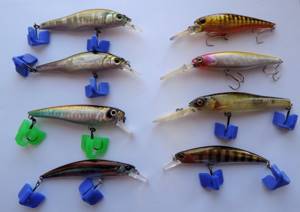
I do not insist that only these wobblers will work; you can choose similar ones in parameters and sizes - they will probably shoot.
The second most popular bait is the spinner. Regular spinner No. 3 Mepps Comet Black Fury. No matter in whose hands this spoon is, the result is excellent. Sometimes you may not have wobblers, but you need to take such a spoon.
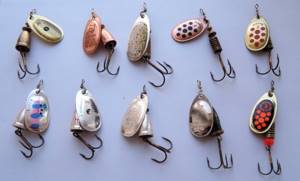
Silicone also works. The same silicone that we used in the lake on the same rig. Sometimes in the middle of summer a pike hides in the grass and stands there. Our silicone bait will help you catch it in the thickets.
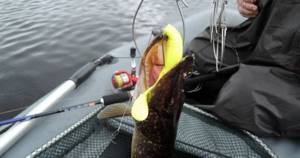
Necessary equipment for pike fishing
Finishing the story about pike fishing, I would like to mention the much-needed things for fishing, which we cannot do without.
And which make life much easier. Take with you:
- yawner and extractor. It can be very difficult to pull out a double or tee that is stuck in the depths of the mouth.
- Sunglasses
- Uncoupling
- Navigator. If you find yourself on a sandbank in the middle of a huge lake, it is best to mark such a place
For novice anglers, we have prepared a number of tips that will help you complete your fishing arsenal.
In general, remember, for successful fishing you need a good mood and desire. The rest will come!
We are waiting for your visit. Come!
Read further about the inhabitants of our reservoirs: chub, ide, grayling, perch.
The influence of weather on pike biting in autumn
Pike does not like sudden changes in temperature and pressure. It is important to take into account the weather preferences of the predator to ensure maximum catch. So, what is the optimal weather for biting and when is the best time to fish?
Pressure
has a greater influence on fish activity than the direction and strength of the wind. The main requirement is stability. The bite is more intense at lower pressure. Ideal atmospheric parameters for pike fishing are from 750 to 760 mm.
Wind
The toothy one is active in weak, warm winds. It is optimal to go hunting if the southwest wind blows. Undesirable directions – eastern, northern. In the complete absence of wind, it is easier to cast a spinning rod, but the pike is more careful at this time (when it is calm, it sees the fisherman).
About
For pike in late autumn
After the October rush, when pikes rush to any piece of hardware, November fishing may seem very boring and unproductive, and you still need to find the strength to rinse your favorite baits in icy water.
Success in pre-winter fishing comes from knowing where fish stop at this time of year (and the sites are usually the same from season to season) and using the “right” baits.
FISHING PLACES
Somehow it is generally accepted that in late autumn, when the water cools, pike goes to the deepest places in reservoirs. It is not always so. On large deep rivers, fish very often come out into open shallow waters. These are vast bays, backwaters, often spits at the tails of large islands. In such places a lot of forage fish always gather - bream, silver bream, roach, schools of which are followed by large pikes. If in summer both the predator and its main food are very spread out across the water area, now all the fish cluster around the meager remains of the once lush underwater vegetation. The concentration of living creatures around such “islands of life” can be very large. There are a lot of pike in the reed islands of large Volga routs and bays, and they are found in the most impassable wilds, in which spinning fishing is in principle impossible. And only in the windiest weather, when the reeds are shaking, does the “toad” come out of it and set up ambushes along its edge. And here it’s a pleasure to catch it, as long as the wave is not very strong - you need to get pleasure from fishing, not seasickness. The trouble is that with the wind in which the pike leaves the reed fields, the wave also rises.
In medium-sized rivers, less than a hundred meters wide, fish at this time of year concentrate around dense rubble of snags. It happens that several hundred meters of the channel pit are empty, and a couple of flooded trees nearby are simply filled with pike. Driftwood is not very difficult to find. Usually, rich reserves of this “good” are located at sharp turns of rivers, the steep banks of which are overgrown with forest. Every spring, during high water, the bank is washed away by water and another portion of “pinocchio” ends up in the river. But if there are very deep holes in the water area (deeper than 10 meters), you should look for fish in them. If there are flooded reeds in the coastal zone of the river, some part of the pike can stand in it, but the size of such “reed” fish almost always leaves much to be desired. From the pre-estuary areas of small and medium-sized rivers, pike most often slide into large rivers. The water there is warmer and the food supply is better.
In closed floodplain lakes and simply swamps, the predator is easiest to find. There she simply has nowhere to go, especially now, when the water level is almost minimal. Particularly rich catches occur in floodplain reservoirs with a maximum depth of less than 1 meter, remaining after the spring flood of large rivers. In the spring, a huge number of pike going to spawn enter them, along with tons of white fish. Subsequently, some of the pike do not have time to roll into the main body of water, and the remains of leucorrhoea and young fish from this spring provide it with an excellent food supply for the whole summer. Just in time for autumn, the food runs out and the angry, hungry and freezing (in the literal sense, because in winter such reservoirs most often freeze to the very bottom), the predator frantically rushes at everything that moves. Frogs, mice, other slightly smaller pikes - everything is a real hunt. The predator usually stays in the very center of reservoirs, at the maximum distance from the banks. The colder the weather, the more active the bite, the peak of which occurs at the moment when in the morning the reservoir is bound by thin ice, and closer to lunch it opens up from the wind or the warmth of the meager autumn sun. There is little vegetation in the swamps now, visibility is excellent, and pikes rush after baits from a distance of more than 20 meters - attacks are always visible by a clearly visible keel wave. This type of fishing is very emotional and exciting, especially when three or even four pikes are thrown at one bait at a time. Surprisingly, in such flood “puddles” there is a chance to catch very large fish, and three to four kilogram pikes are generally caught quite often.
We seem to have sorted out the main fishing spots in late autumn in a nutshell, now we can talk a little about baits.
OSCILLATING SPOONS
The good old oscillators are now coming to the fore. With the help of “pieces of iron” you can equally successfully catch pike both in a huge bay of a deep river and in a small forest swamp. In the Volga backwaters, large but light oscillating spoons work best, those that, when reeled quickly, do not go into a tailspin, and when reeled slowly, lazily roll from side to side. The “Atom” and “Chernospinka” spinners work very well. A real hit is the American Williams spinners with a length of 90 mm. They are quite expensive (plated with silver and even some kind of technical gold), but they work one hundred percent. Excellent results can be achieved with Luhr Jensen (Model Tony`s), Kuusamo (Professor 18 gr.) vibrators. The fishing technique is simple - the spoon is placed with a resounding slap on the border of the reeds (grass) and clean water, buried a little and pulled up quite sharply with the movement of the rod. The bait is “eaten” either at the moment of free fall or during its sharp acceleration. The attention of the predator is attracted by the sound of the fall of the spinner, and its quick pull completely throws it off balance - the grip follows immediately. If there is no bite, you calmly pick up the slack in the fishing line and continue reeling. During this phase, the likelihood of a bite is lower, but it is always worth expecting. The more varied you are with the lure, the more likely it is to be caught by a predator. Alternate accelerations with decelerations, stop reeling, let the lure glide a little in the water column - and you will achieve success.
In small lakes, the bottom of which is covered with thick dead grass, fallen leaves and other debris, it is more convenient to use oscillating spinners in a non-snacking design - with metal mustaches covering the hooks. In this case, there is no competition between non-hook hooks from Kuusamo with a rigidly mounted double hook and Chinese counterfeits, and sometimes the Chinese version works better. When buying a “Chinese”, first of all pay attention to the quality of the double. I have seen several versions of fakes, both with hooks of disgusting quality, and with a branded Mustad lookalike. In any case, the hook tips must be slightly bent outward, thereby increasing the grip. If you have a craving for homemade creativity, try moving the double closer to the middle of the spoon - this will increase the number of effective hooks (and this is the main problem with all unhooked baits). Among other companies, we can note the American Eppinjer non-hook ones. If there is not much grass, you can use regular spoons, replacing the original tee with a thinner one - it makes it easier to “pull” the bait.
Speaking about oscillating spoons, one cannot fail to mention the famous Kastmaster. This obliquely sawn rod is suitable not only for ultra-long-range asp fishing, but also perfectly mows down “swamp” pike. Obviously, the predator is attracted by the peculiar prowling action of this spoon and the low-frequency vibrations it produces. In classic pike swamps, only models weighing 10.5 and 14 grams can be used; heavier spoons simply scrape the bottom, collecting all the debris. Even a 10-gram Castmaster has to be driven quite quickly, with the tip of the spinning rod raised high. It would seem that the wiring is not optimal for pike, the classic “shaker” should work better, but, nevertheless, the pike takes this small spoon perfectly, preferring it to many others. It happens that with other types of spinning lures a spinner sees 2-3 bites in a whole day, but with Castmaster he gets one for almost every cast. This phenomenon is already known to many pike fishermen, and these lures, which at first glance seem unsuitable for pike, have been permanently registered in their boxes. The most catchy retrieve is wavy, sometimes with micro-stops.
JIG AND RUBBER
Fishing with a classic jig is best suited for fishing in medium and large rivers. You will be able to fish normally in a deep hole, a river bed or a snagged dump only if you use jig heads or Cheburashkas (with them, by the way, they are much more convenient) of decent weight and large rubber of soft colors. What kind of rubber it will be - twisters or vibrotails - does not really matter. Sandra twisters of the largest size, the same large models of Relaks twisters, Salt Shaker and Mann`s Spirit vibrating tails with a length of 120 mm work equally well. Sandra and Salt Shaker work best on jig heads, the extra freedom of the body does not benefit them, but all other rubber is used only on the articulated double-Cheburashka rig. Wiring is often classic, winding is a pause, but with a greater number of coil turns than in summer. In cold water, light jig heads are sometimes even more successful than heavy ones. After all, heavy jig is fishing for mostly active fish, although not without exceptions. The big Sandra, for example, works better with weights around 30 grams.
In snags, the greatest success is achieved by the American “edible” rubber YUM Wooly Curltail on a large offset hook. This ribbed “abracadabra” can also help out in the grass, where it is used on an offset press without additional loading. The own weight of large rubber (more than 15 grams) allows you to cast without any problems.
POPPERS AND WOBBLERS
Surprisingly, sometimes a regular popper just works wonders. The ice is about to freeze up, there is almost no grass left, and the pike is greedily taking this noisy bait, usually used at the height of summer. The wiring, of course, is not as aggressive as always, but it’s still strange. The Duel 3D Popper has no competition for this kind of fishing. It flies perfectly and “gurgles” as it should.
Shallow-water wobblers Duel Hardcore modifications “0” and “1” also work great on lakes. With them everything is very simple. Threw it and drag it. Sometimes it is useful to make wiring stops. It is better to replace the original tees with more durable ones. Among other wobblers, one can note the Rapala Husky Jerk 14 cm. It is driven in jerks with pauses of up to three seconds.
ROTATING SPOONS
From the huge variety of “turntables”, only a few models can be distinguished. First of all, these are, of course, Mepps Lusox No. 2 and No. 3, as well as Long No. 3 of the same company. Nothing else comes to mind. In general, spinners are more of a summer bait. In late autumn, they almost always lose to the “wobble” and bulky baits. If you are an ardent fan of “spinners,” you should try ultra-slow wiring of the “Lusox” along the wall of the reeds or over snags, if they are not very deep. In general, don’t get hung up on one thing. Constantly fishing for new baits and experimenting with wiring can bring success in the most unexpected place and in the most unusual combination.
Konstantin KUDINOV November 8, 2006 at 00:00
Features of fishing depending on the month
Fishermen divide autumn fishing into 2 periods: before the aquatic vegetation dies and after, when the algae “fall” to the bottom and the water becomes clear.
September
Fishing still resembles summer fishing. You can find pike in September in the coastal zone, on the shore edge, in overgrown backwaters and shallow bays. The predator stays in the middle layers of water and rises to the surface to attack prey.
October
This is the peak of the seasonal gluttony. Pike leaves the coastal zone, moves to deep areas, enters oxbow lakes and rivers, and hunts near dying banks of aquatic vegetation. The most effective fishing in October is in channel dumps, whirlpools and snags, in deep reaches.
November
Late autumn and the cold weather that comes with it force pike to go deeper into “wintering pits.” The pike spins in the edges of such holes and does not stop feeding throughout the day. The intensity of the bite is no longer affected by the wind, since the fishing takes place at depth. In late autumn, after the first frost, fishing becomes more difficult. The surface of the water is covered with ice, which reduces visibility. The pike stays at depth.
Ideal pike sites
If we combine all the factors we have listed above, we will get ideal places for pike to stay in a pond. 1. Edges of aquatic vegetation, especially those located at differences in depth, on dumps in depth. The pike stands in the grass on the dump and attacks juvenile fish and small perches and pikes. 2. Places on the border between quiet pools and currents. Especially places with reverse flow - “backflow” and turbulence in the water flow. Here the pike attacks with a quick jerk from a quiet place into the current and picks up sick and wounded fish, as well as fish weakened by the fight against the current. 3. Any elevations or depressions on the bottom where the pike can “stay”. Pike attacks passing fish from cover. 4. Any combination of the listed factors greatly increases the likelihood of a pike landing. And good sized holes or snags increase the chance that the predator will be trophy size.

This is what a pike site looks like through the eyes of a fisherman
Video: Pike fishing on the river in autumn
Autumn zhor of pike. Spinning fishing from a boat on the river using wobblers.
Fishing for pike in the fall is an exciting and exciting activity. You need to go out on a quiet hunt after the start of the seasonal feeding season, when the water has cooled and the weather is cool. It is best to catch pike in the fall from a boat. You can find the predator in snags and in aquatic thickets. Wobblers, spinners, or live bait are used as bait.
Views: 388
Similar articles:
- Pike fishing in summer: June, July, August. Where to look, how and what to catch In summer, especially on hot days, the activity of pike noticeably decreases. Large...
- Fishing for pike with live bait in winter: which is better? Pike is a dangerous underwater predator that can destroy...
- How to put live bait on a pike hook Fishing with live bait most often makes it possible to catch really large...
- Catching pike in the fall with a spinning rod Pike is a voracious predatory fish that lives in freshwater bodies of water. Chances...
Pike fishing season
Of course, the palm should be given to the autumn and winter seasons - during these seasons, pike is caught much better. But you can also successfully fish in summer. The main thing to remember is a simple rule - the warmer the water, the deeper you need to look for pike. This rule applies only to lakes; for rivers, another rule applies - the warmer the water, the closer to the riffle you need to look for fish. It is impossible to imagine a pike that has completely stopped feeding.
It is best to catch pike in the morning and evening hours, at this time its activity is maximum. It is advisable to fish for pike from 4.00 to 7.00 in the morning; in the evening the bite is noticeably worse. On rivers the situation is always more favorable. In the morning and evening, pike actively feeds along the coastline; during the day, it climbs into shady places near snags. In hot months, you need to look for it directly in the rifts.

Around the twentieth of June, fishing on the lakes becomes ineffective. This will continue until the first cold weather in August. From mid-June, fishing should be carried out exclusively on rivers.
In August, the pike “releases”; as the water gets colder, the fish begin to actively go out to feed. The bite on the lake remains sluggish, but the river continues to delight with trophies.
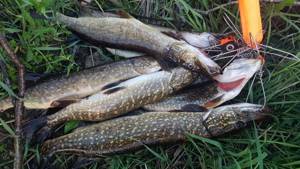
Autumn pike
Autumn in our area lasts two months. Next comes winter. That is why the autumn bite increases every day, and in mid-October the peak of the autumn feeding season begins, it is also called pre-winter. In the second half of September, lake pike become more active. It is especially active in shallow areas of the reservoir and loves to go out onto stone spits. The river is a riot of colors. The pike leaves the riffles and takes up places on the reaches in places with a clear difference in depth. During this period, pike fishing is carried out after the rifts, where it watches over the fish rolling towards the wintering pits.
With the onset of September, pike fishing in the lake begins with a “fighting bait”. It is for the autumn period that we reserve the largest spoons and wobblers, as there is a chance to catch large fish. On the “banks” and edges, medium-sized pike are caught using large spinners and wobblers. From this moment until freeze-up, fishing with anchored circles is very effective. Towards the end of the month, fishing on the river will reach its peak.
October comes and it becomes much colder. Piercing winds begin to blow. With the onset of cold weather, burbot comes across mugs. We continue to move towards the deep edges; the place on the pebbles is now occupied by burbot. The main slogan of October: “Take more - throw deeper.” The situation on the river is similar. You can catch pike all day long using absolutely any large-sized bait.
Time flies quickly and November arrives. The most important question is: will we fish from ice or from a boat? Everything is in the hands of Mother Nature. The situation changes from year to year. If the lakes are not frozen, you can try to catch large pike in the deepest parts of the reservoir. But it’s better to switch to catching burbot; it is most active before freeze-up. The river in November is disappointing; by that time, almost all the fish had rolled into wintering pits and were not feeding very actively.
Fishing methods
As we can see from the material, you can catch pike throughout the year, and the bite doesn’t stop. It can be worse, but it can be better, the main thing is to know how, where and with what.
There are many ways of fishing. We will not list them all, but will focus on those that are most widespread among us. Spinning rods, mugs and summer girders are extremely popular. In winter, fishing takes place on girders and balancers. I will try to give recommendations regarding each fishing method.
Although, sometimes you can catch pike in such an exotic way.
